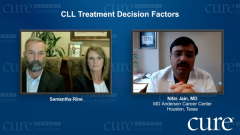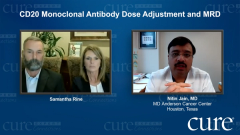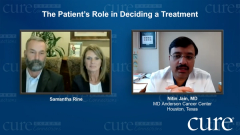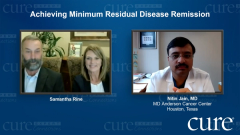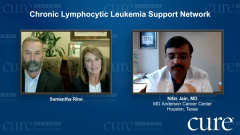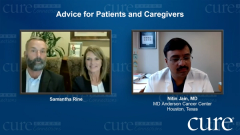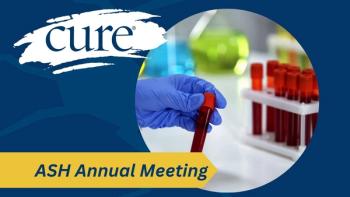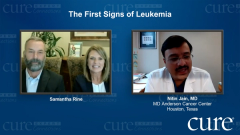
Achieving Minimum Residual Disease Remission
Episodes in this series

Nitin Jain, MD: As we started the therapy, if I recall correctly, we tested your bone marrow at the six-month mark, right? You started sometime last year, the summer of 2019. We tested your bone marrow six months later, which showed MRD [minimal residual disease]-negative remission. That’s the best possible remission you could achieve, and you achieved it within six months of the therapy. That’s really wonderful news. Then we kept you on venetoclax for six more months because the recommendation is to do one year. At that one-year mark, instead of repeating a bone marrow test, we just did a blood test, which again confirmed that you had MRD-negative remission. We stopped venetoclax at that time, as per the plan, and I think now you have been off for a few months now, or maybe more than that?
Samantha Rine: Since June.
Nitin Jain, MD: Since June, so three months. We saw you recently, but we’ll check your MRD again in the blood probably in a few months, on a six-month basis. One of the objectives for a lot of patients is to achieve MRD-negative remission. Back in December when you first learned that you achieved MRD-negative remission, or MRD zero, how did you feel? What was your reaction? What was going on in your mind?
Doug Rine: I’ll start. Honestly, the whole thing seemed like a dream. It wasn’t real the way it started so abruptly. Next thing you know we’re in the hospital, then we’re going through treatment, and six months later there’s no sign of the disease, so obviously something that was wrong was fixed quickly. Not having any side effects from treatments and then being MRD-negative after six months, it made me question if this really happened. It was such a relief because in the back of my mind, there’s always the question of: how is this going to affect us down the road, years from now? To have such a positive outcome so quickly, it was a big relief to be able to get that result.
Samantha Rine: I agree with that. It was a huge relief because even though my journey was unexpected, and relatively easy, there’s still the shock of being diagnosed with cancer. Being a patient with cancer was never in my plans. In the back of my mind, even though all the physical signs are that I feel fine, my daily routine hasn’t changed at all other than I was going in to have the blood work. And like you said, I never knew from visit to visit what my numbers were going to be because I felt the same every single time. It wasn’t until I would get the results back, and you would say, “Oh, your white blood cell count is a little low. We need you to do this, or we need you to do that” that I would know. It’s a disease that doesn’t give you any outward signs or symptoms. You just live with it. That on its own is scary; you’re really sick but you don’t know it. To get the results that I was MRD-negative was a huge relief, and I felt joy, elation, and gratefulness that you and I were able to meet, and I was under your care. I feel that was a huge blessing that I was able to be your patient. I feel lucky.
Doug Rine: I would say luck came into play because we were told after Samantha was admitted that first night that you don’t normally go straight to MD Anderson Cancer Center and get admitted and start treatment. It works through a process where you’re referred and then you go for a visit. Somehow we did a shortcut and got right to you and right to the treatment. It’s such a relief knowing that; and we understand the chronic lymphocytic leukemia is still there. It will be monitored and that’s part of it, but to know that the treatment works. You also told us that with these next tests as part of the follow-up, you’re able to see slight increases in abnormal counts in the blood that will allow you to start treatments again, before it ever gets to a severe level. Having that assurance that there are these little monitoring processes that will be able to allow for treatment at a lower dose and sooner is very comforting.
Nitin Jain, MD: I’m glad you guys came right away, because I think the concern there was acute leukemia when you were diagnosed. But we generally tend to get those patients ASAP to Houston because we know there is a sense of urgency to manage these patients.
Transcript Edited for Clarity


